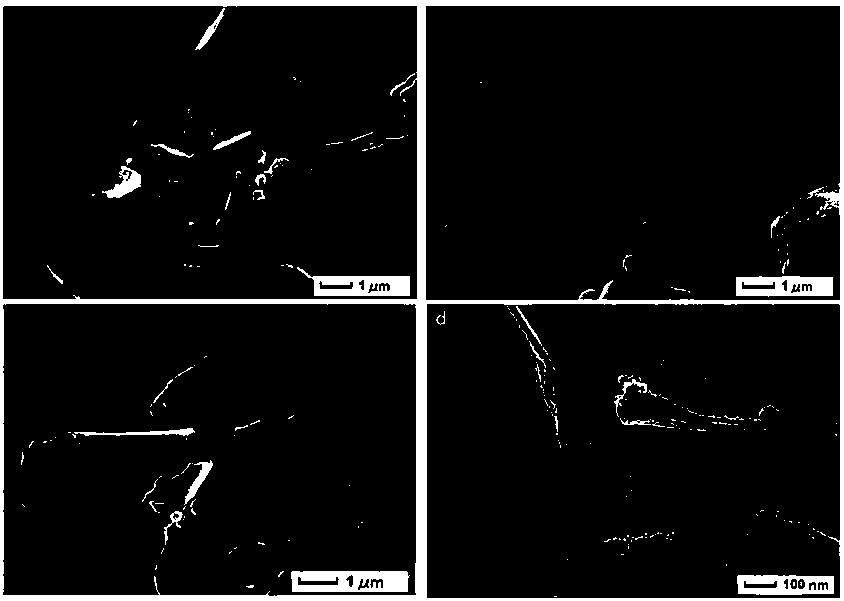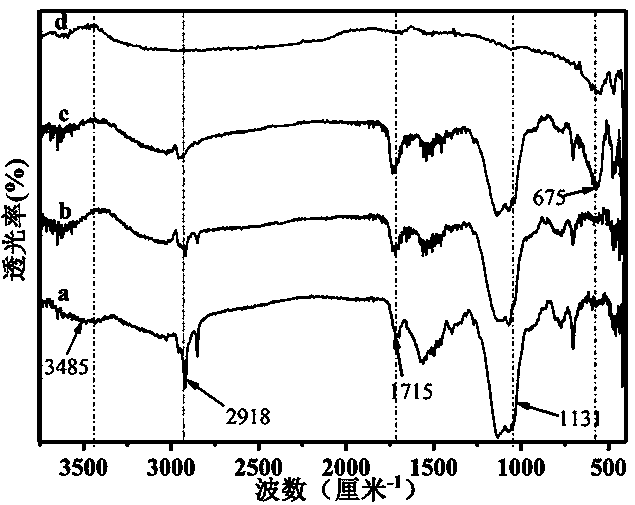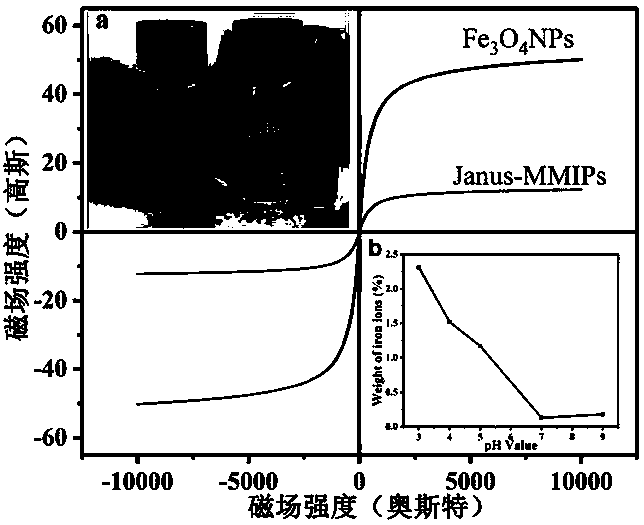Janus magnetic imprinted nanosheet, preparation method and application thereof
A magnetic molecular imprinting, nanosheet technology, applied in chemical instruments and methods, other chemical processes, alkali metal oxides/hydroxides, etc., can solve the overlapping of functional sites and regions, poor separation effect, low selectivity, etc. problem, to achieve the effect of improving specific identification, large adsorption capacity and good selectivity
- Summary
- Abstract
- Description
- Claims
- Application Information
AI Technical Summary
Problems solved by technology
Method used
Image
Examples
Embodiment 1
[0040] (1) Carboxy-modified Fe 3 o 4 Granule preparation
[0041] Mix 100 mL of 0.2 mol / L sodium oleate aqueous solution with 100 mL of 0.2 mol / L ferric chloride aqueous solution. The brown iron oleate complex was obtained by filtration, dispersed with n-hexane, washed three times with distilled water, and dried in a desiccator. Add the complex to 20.0 mL of ethanol containing 10% oleic acid at room temperature. The mixture was transferred to an autoclave and heated to 180 °C for 5 hours. After the reaction, the black oleic acid-capped Fe was washed with ethanol 3 o 4 Nanoparticles (Fe 3 o 4 NPs) and separated with a magnet. The product was redispersed in toluene at a concentration of 10 mg / mL.
[0042] (2) Preparation of Janus nanosheets
[0043] A certain amount of 10 wt% HSMA and water were used as the continuous phase in a beaker, and the pH was adjusted to 3-4 with 2 mol / L HCl solution. Take a certain amount of solid paraffin, add a certain amount of 3-aminopro...
Embodiment 2
[0054] (1) Carboxy-modified Fe 3 o 4 Granule preparation
[0055] Mix 100 mL of 0.2 mol / L sodium oleate aqueous solution with 150 mL of 0.2 mol / L ferric chloride aqueous solution. The brown iron oleate complex was obtained by filtration, dispersed with n-hexane, washed three times with distilled water, and dried in a desiccator. Add the complex to 20.0 mL of ethanol containing 12.5% oleic acid at room temperature. The mixture was transferred to an autoclave and heated to 180 °C for 5 hours. After the reaction, the black oleic acid-capped Fe was washed with ethanol 3 o 4 Nanoparticles (Fe 3 o 4 NPs) and separated with a magnet. The product was redispersed in toluene at a concentration of 10 mg / mL.
[0056] (2) Preparation of Janus nanosheets
[0057] A certain amount of 10 wt% HSMA and water were used as the continuous phase in a beaker, and the pH was adjusted to 3-4 with 2 mol / L HCl solution. Take a certain amount of solid paraffin, add a certain amount of 3-amin...
Embodiment 3
[0063] (1) Carboxy-modified Fe 3 o 4 Granule preparation
[0064] Mix 100 mL of 0.2 mol / L sodium oleate aqueous solution with 200 mL of 0.2 mol / L ferric chloride aqueous solution. The brown iron oleate complex was obtained by filtration, dispersed with n-hexane, washed three times with distilled water, and dried in a desiccator. Add the complex to 20.0 mL of ethanol containing 15% oleic acid at room temperature. The mixture was transferred to an autoclave and heated to 180 °C for 5 hours. After the reaction, the black oleic acid-capped Fe was washed with ethanol 3 o 4 Nanoparticles (Fe 3 o 4 NPs) and were separated by a magnet. The product was redispersed in toluene at a concentration of 10 mg / mL.
[0065] (2) Preparation of Janus nanosheets
[0066] A certain amount of 10 wt % HSMA and water were used as the continuous phase in a beaker, and the pH was adjusted to 3-4 with 2 mol / L HCl solution. Take a certain amount of solid paraffin, add a certain amount of 3-amin...
PUM
 Login to View More
Login to View More Abstract
Description
Claims
Application Information
 Login to View More
Login to View More - R&D
- Intellectual Property
- Life Sciences
- Materials
- Tech Scout
- Unparalleled Data Quality
- Higher Quality Content
- 60% Fewer Hallucinations
Browse by: Latest US Patents, China's latest patents, Technical Efficacy Thesaurus, Application Domain, Technology Topic, Popular Technical Reports.
© 2025 PatSnap. All rights reserved.Legal|Privacy policy|Modern Slavery Act Transparency Statement|Sitemap|About US| Contact US: help@patsnap.com



